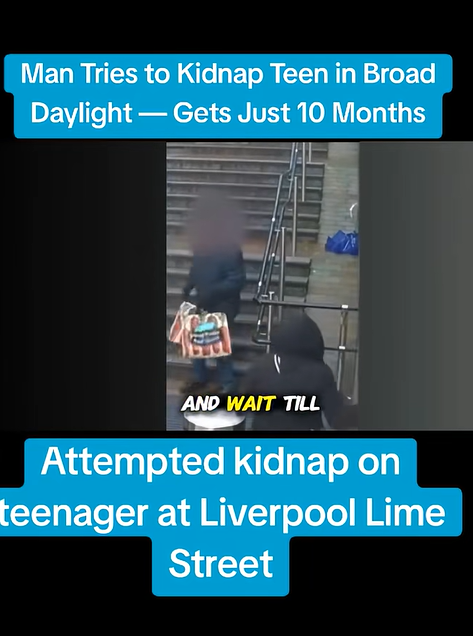The late afternoon sun hung low over Liverpool, casting long shadows across the bustling steps of Lime Street Station. It was October 28, 2024, and the air carried the crisp bite of autumn, mingling with the hum of train brakes and the chatter of commuters. Among them was Sophie Turner, a 19-year-old art student, leaning against a pillar outside the station, her sketchbook tucked under her arm. She was waiting for her friend Mia, who was running late after missing her train from Manchester. Sophie didn’t mind; she loved the energy of Lime Street, the way it pulsed with travelers, street musicians, and the occasional shout of a vendor selling hot coffee. But as the crowd thinned, she felt a prickle on the back of her neck—a sense that someone was watching.
Across the plaza, a man in a worn gray hoodie stood by a newsstand, his eyes fixed on Sophie. He was unremarkable at first glance—mid-20s, unshaven, blending into the urban backdrop. But his stare was unrelenting, and when Sophie glanced up from her phone, their eyes locked for a fleeting moment. She shivered, chalking it up to the chill, and turned her attention back to her screen, texting Mia to hurry. The man, later identified as Daniel Bryce, a drifter with no fixed address, began to move closer, weaving through the crowd with purpose. His hands were stuffed in his pockets, but his gait was deliberate, like a predator circling its prey.
Sophie didn’t notice him until he was just a few feet away. He muttered something under his breath—words she couldn’t make out, slurred and low. Before she could react, his hand shot out, grabbing her wrist with a grip that made her gasp. “Come with me,” he said, his voice rough, his eyes darting nervously. Sophie yanked her arm back, her sketchbook falling to the ground, pages fluttering open to charcoal sketches of the Mersey River. “Let go!” she shouted, her voice cutting through the station’s din. A few heads turned, but most passersby hurried on, absorbed in their own worlds.
Bryce didn’t relent. He pulled harder, dragging Sophie a few steps toward the side of the station, where the shadows of the old Victorian arches loomed. Her sneakers skidded on the pavement, and panic surged through her chest. She screamed again, louder this time, and an elderly couple nearby—a retired postman and his wife, out for an evening stroll—sprang into action. “Oi, leave her alone!” the man bellowed, brandishing his umbrella like a weapon. His wife, clutching her purse, shouted for help, her voice sharp enough to draw a small crowd. Bryce smirked, unfazed, but the distraction gave Sophie a chance to twist free, her wrist red from his grip. She stumbled back, heart pounding, and sprinted toward the station’s main entrance.
Inside, the fluorescent lights and the chatter of the ticket hall felt like a lifeline. Sophie darted toward a British Transport Police officer near the ticket barriers, her words tumbling out in a frantic rush. “He tried to grab me—outside, he’s still out there!” The officer, a seasoned constable named Rachel Patel, radioed for backup and guided Sophie to a bench, where she caught her breath. Meanwhile, Bryce hadn’t fled. He lingered outside, pacing near the steps, as if waiting for another opportunity. CCTV cameras, mounted high above the station, captured every moment—his approach, the struggle, and his eerie calm afterward.
Within minutes, two more BTP officers arrived, spotting Bryce near a taxi rank. He didn’t resist when they apprehended him, his expression blank, almost detached. “I wasn’t doing nothing,” he muttered as they cuffed him, but the footage told a different story. At the station, Sophie recounted the ordeal, her hands trembling as she described the man’s cold grip and the way his eyes seemed to look right through her. The elderly couple, who’d stayed to give statements, praised Sophie’s quick thinking. “She fought like hell,” the postman said, shaking his head. “That lad picked the wrong girl.”
The investigation moved swiftly. Bryce, it turned out, had a history of petty theft but no prior violent offenses. Detectives found no clear motive for the attack—it seemed random, opportunistic, a moment of impulse that could have ended far worse. At Liverpool Crown Court, the trial in April 2025 was brief but intense. The CCTV footage, crystal clear, left little room for defense. Sophie, testifying behind a screen, spoke with a quiet strength that silenced the courtroom. “I just wanted to draw and meet my friend,” she said. “I didn’t expect to have to fight for my life.”
On June 13, 2025, Judge Eleanor Marsden sentenced Bryce to 27 months in prison, calling the incident “a chilling reminder of the dangers faced in everyday spaces.” Sophie, now 20, has since returned to her art, though she avoids Lime Street alone. She’s channeled her experience into a series of stark, haunting sketches—dark figures emerging from urban shadows, their eyes hollow. “It’s how I process it,” she told a local art blog. “I won’t let him take that from me.”
Liverpool has rallied around Sophie’s story. Community groups have pushed for better lighting and more visible patrols at Lime Street, while a crowdfunding campaign raised £6,000 for a local women’s safety charity. For now, the station hums on, its rhythm unbroken—but for Sophie and those who witnessed that autumn day, the shadows of Lime Street linger, a reminder of how quickly the ordinary can turn perilous.
